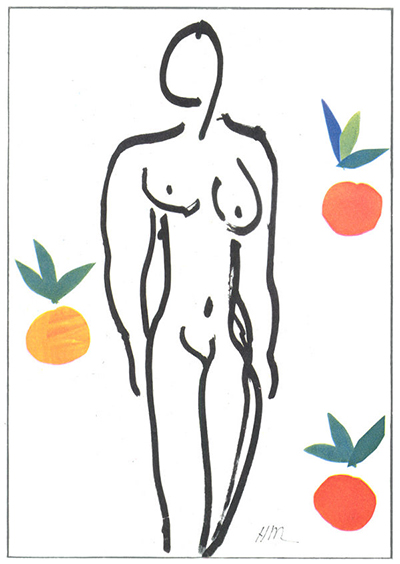Nude with Oranges in a painting by Henri Matisse from 1951, which measures around one and a half metres in height and width. It today resides within a private collection and so is rarely seen in public though it has been identified within a number of publications on the artist's career.
The title itself is fairly self-explanatory as regards the content of this piece. It is delivered using simple abstract lines, without fuss or too much complexity. In the centre of the composition we find a female figure, slim and standing. The figure perhaps looks off to their right whilst positioned front on to us. The minimalist approach ensures many elements of the body are captured with single lines, which might remind some of the work of Pablo Picasso, such as in Dog, Penguin and War and Peace. That said, Matisse had very much his own unique method for figurative art, and expression was a key part of it. Lines did not have to be entirely precise, so long as the overall impression would be understood by the viewer. Matisse chose to incorporate black lines to form the body parts here, and the face is left entirely blank. This creates an anonymity to the model used for this piece and it was common within modern art to work in this manner.
Besides the figure are several fruits which float either side. The fruits are represented by single circles of colour, with attachments of green flourishes which sit just above. Some of the fruits are orange, some pink. Matisse then signed the piece in the bottom right corner. The thick nature of the lines used for the portrait enable it to take our attention first, even though the brighter colour is used elsewhere in this painting. Matisse loved to create form in the simplest of manner during this part of his career and this approach was entirely typical of many artists across the 20th century who were collectively looking to push away from traditional artistic styles, even though their individual methods of doing so would differ substantially from one artist to the next. Matisse himself would encourage others to try cut out techniques, but he also impressed in other mediums such as sculpture, drawing and more.
This artist was highly skilled in portraiture, and was able to deliver form with single strokes of a pen or pencil. This was the rawest display of genius that one can imagine though it would still have taken many years of study and practice in order to reach this point. One familiar with his work can also start to understand his paintings with very little detail, as we begin to speak his language. Many modern artists within the 20th century would go through periods of development across their careers, and reach a state of abstraction over time, perhaps after initially working within a far more traditional method. This was entirely normal and partly influenced by how art education was biased at that time towards more traditional art movements, with artists slowly moving away from these ideas over time.




